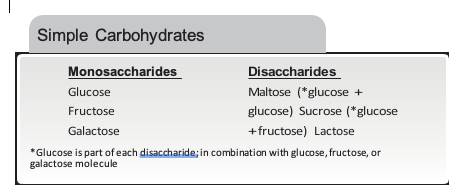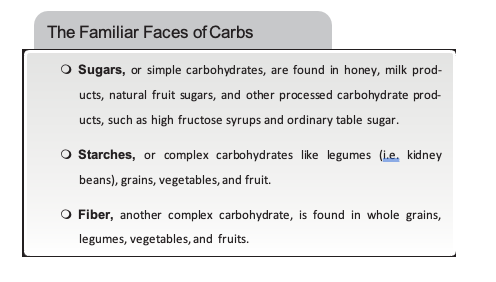As was explained in Part 1, your body requires specific building blocks to help maintain its structure and functions. When you use a smart eating strategy, the same building blocks work together to help you fuel your machine effectively.
Let’s take a look at the resources you have at your disposal to best fuel and run your personal machinery.
Carbohydrates: The Workforce
Never underestimate the power of carbs. This fuel not only does most of the work, but also has say over the operations of all three fuels. A simple carbohydrate has a far greater influence on your weight management goals than any other fuel source. Carbohydrates possess most of the power dictating whether you will burn fuel or store it. Carbohydrate-containing foods even
A simple carbohydrate has a far greater influence on your weight management goals than any other fuel source 30
Body of Knowledge: influence the way you think.
Of all the fuels, carbohydrates need careful management, but the effort is well worth it. If you ingest too many carbs at once, they will cause a flood of the hormone insulin, which locks down fat and sends it to the fat cells for storage. It’s important to note that fat conversion is a lopsided chemical reaction. Once insulin is released, it will store that extra fat we do not burn, then convert extra carbs and protein into more fat. But when we are exercising to burn off the excess fat and our carbohydrate stores dwindle, we cannot reverse this chemical reaction to replenish the carbohydrates.
Insulin acts as the supervisor, ensuring that our bodies do not convert fats back into carbohydrates to burn as fuel! Like me, I hope that once you know the secret of this unfair one-way chemical reaction, you will put carbohydrate management high on your priority list.
Not all Carbs are Equal
Because all carbs are not created equal, you must also pay attention to the quality of carbs that you choose. The type of carbs you eat will also affect insulin release. Scientifically speaking, there are only two general types of carbohydrates: simple carbohydrates and complex carbohydrates. Complex carbohydrates have one broad category: polysaccharides or many (poly) individual sugar (saccharide) molecules hooked together. They come in all different lengths and combinations. Overall, complex carbs should always be your first carb choice at mealtime because they enter your bloodstream slower and thus release less insulin.
This makes complex carbs a better quality fuel for weight management and better health. But do not fixate on them. Simple carbs are necessary too for things like exercise performance and mental functions.Simple carbohydrates have two categories: disaccharides (two sugar molecules) and monosaccharides (one sugar molecule). The monosaccharides go by the names glucose, fructose, and galactose. The disaccharides—maltose (found in beer), sucrose (table sugar), and lactose (found in milk) are just differ- ent combinations of the three single sugars. Now that you have passed Saccharide 101, let’s apply your new knowledge to everyday foods that we all recognize.
Before the birth of the carbohydrate-bashing high-protein diets, carbs were commonly known by their three friendly subsets: sugars, starches and fiber.
All of these foods have complex and/or simple carbohydrates in them, although the amounts vary. So it is both the food type and the make-up that matter when it comes to your diet.

Sugar Highs and Lows
Refined sugar is not a creation of Mother Nature. She does, however, provide sugar in unprocessed foods, such as fruits, honey, milk products, and certain vegetables. The difference in how your body processes refined sugar compared to sugars that exist in natural foods is revealed in the popularized glycemic index (GI).Since not all simple or complex carbs are processed the same way in our bodies, the GI provides a scale that shows how each food item containing carbohydrates compares to pure glucose absorption—a GI value of 100. The GI provides a scale that shows how each food item containing carbohydrates compares to pure glucose
The lower the GI, the less sugar is absorbed into your bloodstream (and usually less insulin released) after eating a particular food item. Table sugar, white flour, and almost all the other processed carbs have a higher glycemic index (70 and above), while some fruits and most vegetables have a lower glycemic index. For example, apples contain “fruit sugars” and different varieties only have aGI range of 30-40. The complex carbohydrates in fruits and vegetables are responsible for this difference. You can search for foods with a particular GI on the website. Glycemic Index and GlycemicLoad Ranges
Fructose is unique because it is not really detected by the glycemic index since the test is sensitive only to glucose—the common sugar in all carbohydrates, simple and complex. Fructose’s inherent low glycemic index has made it a very popular sweetener in snacks, prepared foods, and protein bars, but new re- search shows that it’s a pay-now or pay-later situation. When fructose enters the blood stream, it is sent to the liver, where it is converted into glucose. Eventually a similar glycemic load and total sugar metabolism is delivered to your body. Light on the StarchThis broad category is mainly made up of vegetables, grains, and legumes, but many fruits also contain the starchy polysaccharides. They are all complex carbohydrates, although some can have a rather high glycemic index. As al- ways, it depends on the amount of fiber they contain and the processing that takes place. While eating processed wheat products is not as good as eating tomatoes, choosing the whole grain types is a better choice overall. For example, eat whole grain pasta (which contains more fiber) instead of pasta made with enriched flour.Potatoes and other “tubers” get a bad rap because their glycemic index is quite high. These root vegetables are the carbohydrate storage bins of the plant world.
It’s not the concentration of carbs that is the problem; it’s how we prepare them. In general, raw is better than cooked for any and all unprocessed carbo-hydrate-containing foods.The heat that is generated during cooking breaks down the strong chemical bonds that hook complex carbohydrates together and make them work so well for weight management. Carbohydrates from cooked vegetables have a higher GI and enter the bloodstream faster than uncooked veggies because the long complex chains of glucose break down into more simple sugars during the cook- ing process.Of course, eating a raw potato or yam is not enticing and raw rice, wheat or corn is really not an option. However, carrots, broccoli, celery and other fiber-filled vegetables are great raw and crunchy.
Eaten raw, you can be sure that the carbs are at their lowest possible GI, entering your system in a slow-release mode and keeping insulin at its lowest possible level (not to mention better vita- min and mineral absorption).
Be Fiber Optic
Fiber is about as close as we can get to a dream food that contains little to no calories. Fiber is a complex carbohydrate that remains essentially unaltered in its journey through the body, which should make it another carbohydrate of choice. Your best fiber choices are vegetables, fruits, legumes, and whole grains. Fiber falls into two scientific categories: insoluble and soluble.m Insoluble fiber does not attract or dissolve in liquid of any type. Bran is a great example of insoluble fiber. This type of fiber can pass through your body without being digested—virtually unchanged and unaltered. It keeps your gastrointestinal system clean, healthy, and moving.m Soluble fiber has a different advantage. It can absorb liquids, which means that your stomach will register more bulk from fewer calories, especially when it soaks up some of the contents in your stomach. Furthermore, certain soluble fiber has been shown to attract and trap fats. Like cleaning up an offshore oil spill, fiber from unprocessed foods or over the counter supplements, such as psyllium, can reduce the overall fat absorption into your bloodstream. If you drink these supplements for regularity, do so after your biggest meal and take advantage of this extra benefit.In the end, the smart choice is easy. Stick to unprocessed complex carbs with fiber to keep your machine running better and longer.


